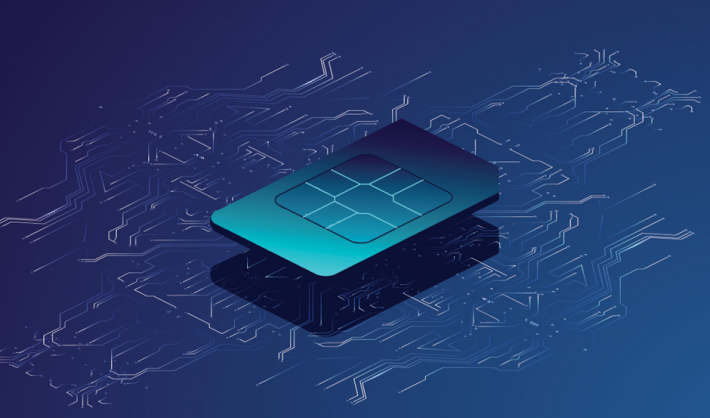Up to now, IoT has always had to use standard plastic SIMs, but eSIM is changing all that with the potential for increased openness and flexibility. In this article, Robin Duke-Woolley, CEO of Beecham Research reveals how to select the best eSIM solution for your IoT deployment.
Plastic SIM card vs eSIM
The original SIM card – the plastic card inserted into your mobile phone to determine which network operator (MNO) your phone is assigned to – has essentially not changed much since it first came to the market in 1991. It has been well suited to the sales process in specialist mobile retail stores, where the SIM is inserted into the phone at the point of sale.
Why should you use eSIM for IoT?

The situation for connected devices in the machine to machine (M2M) market, and then IoT, has always been entirely different. These devices, such as asset trackers, cars, CCTV cameras, healthcare devices, security alarms and smart meters, are usually shipped direct to where they will be used, and the plastic SIM cards then have to be matched up with them on site. This has always been logistically challenging but has become increasingly untenable as the volumes of manufactured devices requiring to be connected have risen sharply in recent years. A particular case in point is auto manufacture, but many others as well. eSIM provides the way forward for this, a solution where unassigned SIM components (called eUICCs – embedded universal integrated circuit cards) can be built into devices during manufacture and then updated with the most appropriate MNO profile over the Air (OTA) when they are switched on in the field. Using cloud-based services, this allows them to automatically find the local MNO assigned to their contract, establish the connection and start sending back data from the IoT device. It also means that the assigned MNO can now be changed remotely, for example at a contract renewal, without having to resort to changing out physical SIM cards in all devices wherever they happen to be.
The eSIM market is growing strong

The introduction of the eSIM Technical Specification by the GSMA in 2014, and continuously updated since then, provides a technical standard for this type of solution and this has considerably enhanced the prospects for eSIM use in the IoT market. As shown in Figure 1, projections for use of eSIM for M2M/IoT applications are now growing strongly with market expectations high that nearly two thirds of all new cellular IoT connections – both high and low bandwidth – will be eSIM based by 2022. Further, since growth of eSIM for low bandwidth NB-IoT and LTE-M is behind and catching up, growth of eSIM for high bandwidth connections is well ahead of that. This means that the majority of new cellular IoT connections will use eSIM and its related developments, such as integrated SIM (iSIM), within the next few years. The IoT market is just at the start of exploring the new ways of working and the new operational flexibilities that eSIM now offers for IoT business users
Not all eSIM solutions are created equal

While the interest in eSIM is high, finding the right eSIM solution for your IoT device requirement can be complex, especially where this requirement is global in nature. For example, only some MNOs in any given country may have the required level of service. If the devices to be connected require best coverage and high data rate (such as 4G) in each country, then that may require connections through a different choice of MNOs than for reasonable coverage at low (say 2G or LTE-M) data rate. The tariffs charged will then reflect that choice.
According to the GSMA there are over 800 GSM licensed MNOs in the world in over 200 countries. All of these have IoT roaming agreements, but very few if any have direct agreements with everyone else. Even if they do, the usage of that agreement determines the tariff they have available for their customers. If their usage is low, the tariff may be quite expensive compared with another MNO whose usage is higher.
How eSIM offers IoT business users more flexibility

Figure 2 illustrates an example tailored eSIM connectivity plan for a business looking to have the right range of countries for their connected devices. “Tailored” means that the plan has been designed specifically for that business. The connectivity is organised by an eSIM connectivity provider who has a wide range of MNO agreements and associated network profiles. The range of countries required is found to be best covered by MNOs 1-15. These MNOs have been chosen in order to ensure that the required connected device experience is met, for example the geographic coverage required in each country and the data rate required (NB-IoT, LTE-M, 4G and others). In this way, the connection to MNO1 also provides access to MNOs 2 and 3. Although MNO1 has a roaming agreement with MNO4, it is better for the eSIM connectivity provider to connect directly to MNO4 as it then provides access to MNOs 5 and 6 through favourable roaming agreements. In the same way, although connection to MNO7 also provides access to MNO 8, direct connection to MNO8 also provides access to MNOs 9-11 through favourable roaming agreements.
As is clear in figure 2, given that the business user requires a particular experience for their connected devices in a large number of countries, establishing the best rates for that coverage can be complex. It may therefore seem simpler just to opt for a global SIM provided by one MNO that offers coverage using the roaming agreements that the MNO has worldwide. That is then often provided by means of a locked eSIM that cannot be changed for the life of the product. Yet this approach may not in fact provide the optimum geographic coverage for the data rate required within each country and overall may cost more than an alternative that does provide this. If it is locked, it cannot then be changed.
The difference is then between a one-size-fits-all global SIM solution that is not designed for the specific requirement and an open and flexible eSIM solution tailored to the specific needs of the business user. The former solution cannot adapt to any changes required by the user that come about over time, whereas the latter remains open and flexible to such changes.
How eSIM makes permanent IoT roaming easy

A related issue is permanent IoT roaming. In some countries, a device that is roaming permanently in a country when its home country is elsewhere contravenes local regulations and may be disconnected. This is a changing situation and the number of countries where this is an issue may increase over time. This is easily overcome using an open eSIM approach, where a local network profile can be uploaded as required. A further area that may also need to be considered are local government regulations covering IoT data sovereignty – local country regulations aimed at ensuring that data originating in a country stays in that country. This has implications for choice of carrier in some countries for some applications and this trend is expected to increase over the next few years.
One such tailored approach is provided by iBASIS as part of its patented Global Access for Things offering. Using their Open eSIM and their own-designed Mobile Network Selection Logic (MNSL), iBASIS can offer such plans covering virtually all countries worldwide that are either country-based or zone-based (zones of countries) as global plans specifically for eSIM use. This selection logic also takes into account data sovereignty requirements in those countries where they currently exist, and this can be updated for any country at any time.
When should an eSIM be used for IoT devices?

The eSIM solution is aimed at all IoT application areas, with different objectives for different IoT use cases as follows:
1. Future-proofing – for devices that are in the field for many years. Some IoT devices can have a very long life, for example a smart meter or home alarm system. These may be in place for ten to 15 years or more and are not usually in particularly easy-to-access locations. Committing to a network contract effectively for the life of the product can be expensive for the business if the network charges are usually declining on a year-by-year basis. It may be difficult to negotiate a reduction in those charges over time and the alternative of changing out the SIM for another operator could be costly. The alternative is to equip the IoT device with an eSIM capability where the network operator can be changed at contract renewal. This change may not in fact happen, but the fact that it might considerably strengthens the bargaining position of the customer.
2. Single SKU (Stock Keeping Unit) – for devices that may be shipped anywhere in the world. In this case, an eSIM capability is embedded in the product during manufacture with a bootstrap network profile. When switched on, the device is automatically connected over the air to the Remote SIM Provisioning system and the correct network operator profile for that device downloaded to it. It is then fully connected and working. This avoids the difficulties of having to match up pre-ordered physical SIM cards with manufactured products that could end up anywhere in the world and may be distributed through complex supply chains or even normal retail channels that are not equipped to handle contract-based SIM cards.
This use case was pioneered by the auto manufacturers, where using traditional SIM cards adds greatly to the logistical issues and cost. In the typical business case for this, the auto manufacturer pays for an initial period of connectivity (often between one and three years) which the car owner can then take over from. At that point, the car owner may prefer to use a different network operator. This method also enables the transfer to subsequent car owners in the second-hand car market.
3. High Availability/Active Switching – for an increasing variety of mobile applications. One example is for when there is a need to have an optimal connection at all times, for example catering for life safety and security. This may require switching between different networks to cater for coverage limitations, including crossing borders and network null points. This is not a roaming issue. It is the ability to dynamically switch to the most appropriate operator network to ensure high network availability at lowest cost. A second example is for connecting internet services on ocean-going cruise liners or aircraft, which need to be connected automatically to different high-speed networks at every port they arrive in.
This report first appeared inside IoT Now magazine.
Subscribe now to access free reports, webinars, and a quarterly digital magazine










